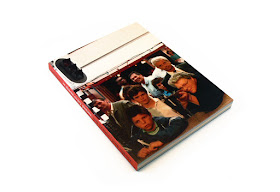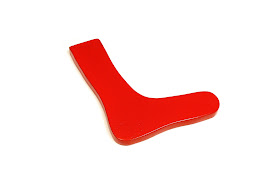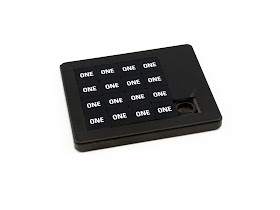William Cobbing and Rosie Cooper [eds]
Boooook: The Life and Work of Bob Cobbing
London, UK: Occasional Papers, 2015
208 pp., 17 x 24 cm., softcover
Edition size unknown
Founded by Sara De Bondt and Antony Hudek in 2008, Occasional Papers is
a non-profit publisher of books devoted to the histories of architecture, art, design, film and literature. They have produced works by Stephen Willats and John Latham, as well as titles on artists' ephemera (the catalogue to the MoMA Library exhibition
Please Come to the Show) and concrete poetry (
Notes From the Cosmic Typewriter).
Their most recent title,
Boooook: The Life and Work of Bob Cobbing, is the first comprehensive overview of the life and work of the pioneering British poet and publisher. Cobbing, who died at the age of 82, fourteen years ago, has been called "the major exponent of concrete, visual and sound poetry in Britain."
Edited by grandson William Cobbing and Rosie Cooper, the volume takes its title from the name of a planned but never opened bookstore. Cobbing had managed the legendary Better Books on Charing Cross Road from 1965 to 1967, and when it closed he found a location a few blocks away that could house a bookstore on the ground floor and a dedicated projection space and auditorium in the basement. Start-up funds were raised and promotional materials were printed, but a noisy party the day before the lease was to be signed gave the landlord cold feet and he cancelled the agreement.
Prior to his involvement with Better Books, Cobbing founded Writers Forum, which operated as a small imprint, workshop and writers' network. Between 1963 and 2002 Writers' Forum published more than a thousand books and pamphlets, including works by John Cage, Ian Hamilton Finlay, Allen Ginsberg, Brion Gysin, poet Maggie O'Sullivan and satirist P. J. O'Rourke. Cobbing also published recordings of sound poetry by Henri Chopin and Francois Dufrene.
This dedication to publishing allowed his own work to blur the processes of writing, design and printing. His poems were typed, mimeographed (on his preferred Gestetner), photocopied, letter-pressed, and screen printed. His style was sometimes labelled 'dirty concrete', a sub-category of the genre that Derek Beaulieu defines as "concrete poetry which foregrounds the degenerated, the broken and the handmade".
His work on the page was often the springboard for a performance which involved stretching language ("until it broke" notes the book's editors) through the deployment of shouts, sneezes, hisses, and groans. He produced several albums, collaborating with abAna, Birdyak and David Toop. One of his best known works,
ABC In Sound, was recorded for the BBC Radiophonic Workshop and broadcast January 7th, 1966.
"We are aided in our search by sophisticated instruments, the microphone and tape-recorder," he told Source magazine in 1970. "Our human voices extend the range of the tape-recorder’s abilities by their demands upon it. Conversely, the tape- recorder’s treatment of the voice teaches the human new tricks of rhythm and tone, power and subtlety . . . We are in a position to claim a poetry which is musical and abstract: but, however hard we try to do so, can we escape our intellect? No, but in the poetry of pure sound, yes."
Cobbing is well-known in sound and concrete poetry circles, and will be familiar to many in the artists' books community through his inclusion in various important anthologies. Alongside these activities,
Boooook emphasizes
Cobbing's efforts as an organizer and impresario. “We wanted to highlight his position as a key player in some of the most important moments and movements of the British avant garde,” write Cooper and Cobbing. "Such a large part of Bob's work was about facilitating other people, setting things in motion rather than promoting himself."
Cobbing collaborated with Gustav Metzger to present a series of projects for the legendary
Destruction in Art Symposium in 1966. The three-day event featured lectures and performances by artists affiliated with Fluxus (George Maciunas, Yoko Ono, Robin Page), Happenings (Al Hansen, Wolf Vostell), Sound Poetry (Henri Chopin) and Viennese Actionism (Günter Brus, Otto Mühl, Hermann Nitsch). Who guitarist Pete Townsend was reportedly in the audience (he was a student of Metzger's) and became inspired to later destroy his guitar on stage as a form of "auto-destructive art", thus inventing a rock concert trope that continues unabated, fifty years later.
Some of the
DIAS events took place at Better Books, including a programme titled ‘Cinema 65’, which led to the formation of the London Filmmakers’ Co-op. A year prior the store hosted a reading by Allen Ginsberg that led to the International Poetry Incarnation.
Boooook highlights these connections and the key roles Cobbing played in a variety of artistic and counter-cultural events in the sixties.
The title is illustrated with numerous reproductions of artworks and ephemera (documents, posters, poems, film stills, etc.) and features contributions by the editors, Adrian Clarke, Arnaud Desjardin, Sanne Krogh Groth, Will Holder, Gustav Metzger, Marc Matter & Tris Vonna-Michell, David Toop, Steve Willey, Andrew Wilson and Maxa Zoller.
The book is the culmination of a year-long programme of events that happened under the umbrella name
Bob Jubilé. It kicked off with an exhibition titled
ABC in Sound at the Exhibition Research Centre, and also included numerous performances, a symposium, and a conversation with Kenneth Goldsmith. For more information, visit
http://www.bobjubile.org.is available from the publisher,
here, for £20.





































































